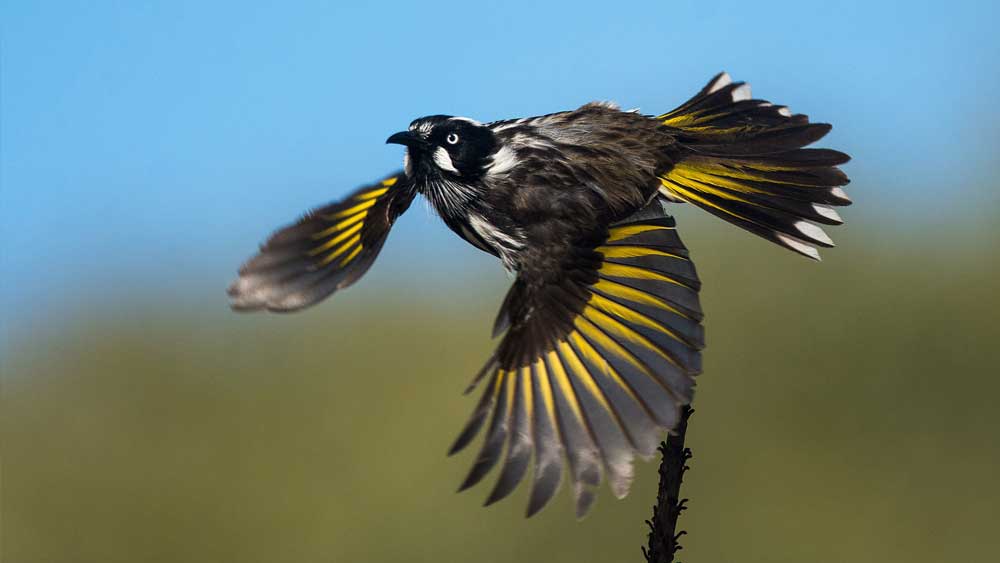High-speed creature communication has been making the news recently. There was underwater research on deep-sea squid,1 and now bird communication. In fact, the rapid signaling discovered in the honeyeater bird is all part of an intricate multi-part message that has scientists in awe at both its rapidity and complexity.2
The honeyeaters are a large and diverse family of small to medium sized birds mostly found in Australia and New Guinea. When a honeyeater is threated with a predator, such as a hawk, it gives out an alarm call in the blink of an eye. Researchers have analyzed this life-saving message in detail and uncovered a level of rapid-fire complexity never realized before.
When a hawk has spotted a honeyeater it wants for lunch, it will swoop down at a very high velocity on its target. The honeyeater has only a split second to flee to for cover. This fraction of a second makes the difference between life and death. During this brief time point, the honeyeater is not only engaging in rapid evasive maneuvering, but is giving out a two-stage alarm to warn its buddies.
Other types of animals are also known to signal urgent danger using repeated sounds, but often take a longer amount of time to deliver. The problem facing the honeyeater is how to make a lightning-fast information-rich message to benefit the other birds while staying alive at the same time. Fortunately, God has hardwired such programming and linguistic ability into the bodies and behavior of this bird.
When the honeyeater gives out this important message, it “front-loads” the information concerning urgency into the first note of the alarm call, allowing other honeyeaters to respond quickly and take cover. Then the honeyeater tags on more specific notes to reinforce the message and signal information to the others on how long they need to remain hidden. And these messages will get longer with more notes in direct relationship to the level of threat.
Evolutionists are at a loss to explain how this highly sophisticated rapid-fire adaptive communication trait within a complex social context could have arisen through random evolutionary processes. A complex multi-level trait like this would involve hundreds of genes to produce the sound producing and sound receiving systems (organs) in the bird. Plus, these birds need the built-in ability to recognize and decode the sophisticated messages. These amazingly sophisticated trait systems can only be the work of an all-powerful Creator that engineered these honeyeaters in the beginning.
References
1. Tomkins, J.P. Deep Water Squid Communication Mystifies Scientists. Creation Science Update. Posted on ICR.org March 27, 2020, accessed April 1, 2020.
2. Potvin, D.A. et al. 2018. Birds Learn Socially to Recognize Heterospecific Alarm Calls by Acoustic Association. Current Biology. DOI: 10.1016/j.cub.2018.06.013.
*Dr. Tomkins is Life Sciences Director at the Institute for Creation Research and earned his doctorate in genetics from Clemson University.

High-Speed Bird Communication Is Complex
The Latest
The Jaw Drops an Evolutionary Explanation
The lepidosaurs are a large and diverse group of land vertebrates that include the snakes and lizards. There are almost 12,000 species of these animals....
''Super-Puff'' Exoplanets: Evidence of Youth?
Astronomers have inferred the presence of a fourth exoplanet in the Kepler-51 star system.1,2 They made the discovery when the third exoplanet...
A Fresh Start
"That ye put off concerning the former conversation the old man, which is corrupt according to the deceitful lusts; And be renewed in the spirit...
January 2025 ICR Wallpaper
"For behold, I create new heavens and a new earth; And the former shall not be remembered or come to mind." (Isaiah 65:17 NKJV)
ICR...
All Things New
"And he that sat upon the throne said, Behold, I make all things new. And he said unto me, Write: for these words are true and faithful."...
Creation Kids: Neptune
by Renée Dusseau and Susan Windsor*
You're never too young to be a creation scientist and explore our Creator's world. Kids, discover...
Theodore Roosevelt National Park: Testimony to the Receding Flood
by Tim Clarey, Ph.D., and Mike Mueller, M.S.*
Nestled next to Medora, North Dakota, and 45 miles east of Glendive, Montana, Theodore Roosevelt National...
A Great Year of Development! 2024 Year in Review
The Institute for Creation Research had another outstanding year advancing creation science in 2024! We’ll use this opening issue of Acts &...
APOLOGETICS
Mice That Prey on Scorpions and Tarantulas
Don’t underestimate the ferocity of a humble-looking little mouse—especially if it lives inside Grand Canyon.
Although various mice...
The Courage of Conviction
Several years ago, a young pastor assumed leadership of his father’s church. The church was located in a large city with an increasing population...













